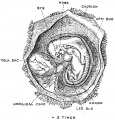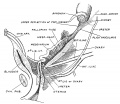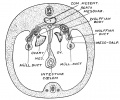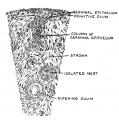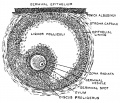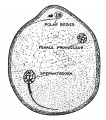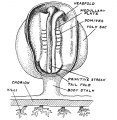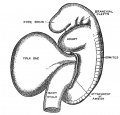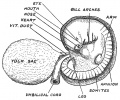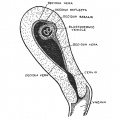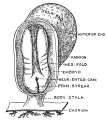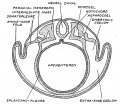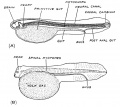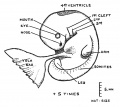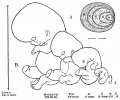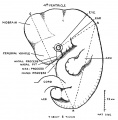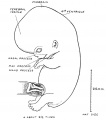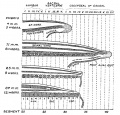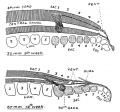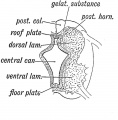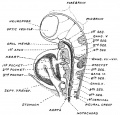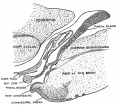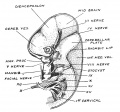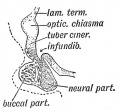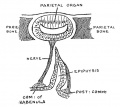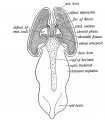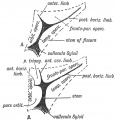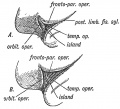Human Embryology and Morphology - Figures: Difference between revisions
| Line 149: | Line 149: | ||
<gallery> | <gallery> | ||
File:Keith1921 fig094.jpg| | File:Keith1921 fig094.jpg|Fig. 94. Brain of a Larval Fish primary form and relations of the fore-brain. | ||
File:Keith1921 fig095.jpg| | File:Keith1921 fig095.jpg|Fig. 95. The Brain of the Lamprey from above. | ||
File:Keith1921 fig096.jpg| | File:Keith1921 fig096.jpg|Fig. 96. Fore-Brain at the beginning and end of the 4th week. | ||
File:Keith1921 fig097.jpg| | File:Keith1921 fig097.jpg|Fig. 97. The Thalamencephalon towards the end of the 6th week. | ||
File:Keith1921 fig098.jpg| | File:Keith1921 fig098.jpg|Fig. 98. Embryonic Fore-Brain various parts linked to sensory tracts. | ||
File:Keith1921 fig099.jpg| | File:Keith1921 fig099.jpg|Fig. 99. Pituitary Body of a Human Foetus in the 5th month. | ||
File:Keith1921 fig100.jpg| | File:Keith1921 fig100.jpg|Fig. 100. Pineal Body and its commissure and ganglion. | ||
File:Keith1921 fig101.jpg| | File:Keith1921 fig101.jpg|Fig. 101. Pituitary Body of a Pup Dog-Fish. | ||
File:Keith1921 fig102.jpg| | File:Keith1921 fig102.jpg|Fig. 102. Development of the Pituitary. | ||
File:Keith1921 fig103.jpg| | File:Keith1921 fig103.jpg|Fig. 103. Pituitary Body of a Human Foetus at the beginning of the 4th month. | ||
File:Keith1921 fig104.jpg| | File:Keith1921 fig104.jpg|Fig. 104. The Pineal Gland and Sense Organ in a Lizard. | ||
File:Keith1921 fig105.jpg| | File:Keith1921 fig105.jpg|Fig. 105. Showing stages of development of the Pineal Body in the roof of the Fore-Brain | ||
</gallery> | </gallery> | ||
Revision as of 18:07, 28 December 2014
Keith, A. Human Embryology And Morphology (1921) Longmans, Green & Co.:New York.
Human Embryology and Morphology: 1 Early Ovum and Embryo | 2 Connection between Foetus and Uterus | 3 Primitive Streak Notochord and Somites | 4 Age Changes | 5 Spinal Column and Back | 6 Body Segmentation | 7 Spinal Cord | 8 Mid- and Hind-Brains | 9 Fore-Brain | 10 Fore-Brain Cerebral Vesicles | 11 Cranium | 12 Face | 13 Teeth and Mastication | 14 Nasal and Olfactory | 15 Sense OF Sight | 16 Hearing | 17 Pharynx and Neck | 18 Tongue, Thyroid and Pharynx | 19 Organs of Digestion | 20 Circulatory System | 21 Circulatory System (continued) | 22 Respiratory System | 23 Urogenital System | 24 Urogenital System (Continued) | 25 Body Wall and Pelvic Floor | 26 Limb Buds | 27 Limbs | 28 Skin and Appendages | Figures
| Historic Disclaimer - information about historic embryology pages |
|---|
| Pages where the terms "Historic" (textbooks, papers, people, recommendations) appear on this site, and sections within pages where this disclaimer appears, indicate that the content and scientific understanding are specific to the time of publication. This means that while some scientific descriptions are still accurate, the terminology and interpretation of the developmental mechanisms reflect the understanding at the time of original publication and those of the preceding periods, these terms, interpretations and recommendations may not reflect our current scientific understanding. (More? Embryology History | Historic Embryology Papers) |
Note some of these figures are the same as those used in the earlier 1902 first edition.
Early Changes in the Development of the Ovum and Embryo
The Manner in which a Connection is Established between the Foetus and Uterus
2 Connection between Foetus and Uterus
The Primitive Streak, Notochord and Somites
3 Primitive Streak Notochord and Somites
The Age Changes in the Embryo and Foetus
The Spinal Column and Back
The Segmentation of the Body
Central Nervous System — Differentiation of the Spinal Cord
The Mid- and Hind-Brains
The Fore-Brain or Prosencephalon
The Fore-Brain or Prosencephalon (continued) Cerebral Vesicles
10 Fore-Brain Cerebral Vesicles
The Cranium
- Keith1921 fig132.jpg
- Keith1921 fig133.jpg
- Keith1921 fig134.jpg
- Keith1921 fig135.jpg
- Keith1921 fig136.jpg
- Keith1921 fig137.jpg
- Keith1921 fig138.jpg
- Keith1921 fig139.jpg
- Keith1921 fig140.jpg
- Keith1921 fig141.jpg
- Keith1921 fig142.jpg
- Keith1921 fig143.jpg
- Keith1921 fig144.jpg
- Keith1921 fig145.jpg
- Keith1921 fig146.jpg
- Keith1921 fig147.jpg
- Keith1921 fig148.jpg
- Keith1921 fig149.jpg
- Keith1921 fig150.jpg
Development of the Face
- Keith1921 fig151.jpg
- Keith1921 fig152.jpg
- Keith1921 fig153.jpg
- Keith1921 fig154.jpg
- Keith1921 fig155.jpg
- Keith1921 fig156.jpg
- Keith1921 fig157.jpg
- Keith1921 fig158.jpg
- Keith1921 fig159.jpg
- Keith1921 fig160.jpg
- Keith1921 fig161.jpg
- Keith1921 fig162.jpg
- Keith1921 fig163.jpg
- Keith1921 fig164.jpg
- Keith1921 fig165.jpg
- Keith1921 fig166.jpg
- Keith1921 fig167.jpg
- Keith1921 fig168.jpg
- Keith1921 fig169.jpg
- Keith1921 fig170.jpg
- Keith1921 fig171.jpg
- Keith1921 fig172.jpg
- Keith1921 fig173.jpg
- Keith1921 fig174.jpg
- Keith1921 fig175.jpg
- Keith1921 fig176.jpg
- Keith1921 fig177.jpg
- Keith1921 fig178.jpg
- Keith1921 fig179.jpg
- Keith1921 fig180.jpg
- Keith1921 fig181.jpg
- Keith1921 fig182.jpg
- Keith1921 fig183.jpg
The Teeth and Apparatus of Mastication
- Keith1921 fig184.jpg
- Keith1921 fig185.jpg
- Keith1921 fig186.jpg
- Keith1921 fig187.jpg
- Keith1921 fig188.jpg
- Keith1921 fig189.jpg
- Keith1921 fig190.jpg
- Keith1921 fig191.jpg
The Nasal Cavities and Olfactory Structures
- Keith1921 fig192.jpg
- Keith1921 fig193.jpg
- Keith1921 fig194.jpg
- Keith1921 fig195.jpg
- Keith1921 fig196.jpg
- Keith1921 fig197.jpg
- Keith1921 fig198.jpg
- Keith1921 fig199.jpg
- Keith1921 fig200.jpg
- Keith1921 fig201.jpg
- Keith1921 fig202.jpg
Development of the Structures concerned in the Sense of Sight
- Keith1921 fig203.jpg
- Keith1921 fig204.jpg
- Keith1921 fig205.jpg
- Keith1921 fig206.jpg
- Keith1921 fig207.jpg
- Keith1921 fig208.jpg
- Keith1921 fig209.jpg
- Keith1921 fig210.jpg
- Keith1921 fig211.jpg
- Keith1921 fig212.jpg
- Keith1921 fig213.jpg
- Keith1921 fig214.jpg
- Keith1921 fig215.jpg
- Keith1921 fig216.jpg
- Keith1921 fig217.jpg
- Keith1921 fig218.jpg
- Keith1921 fig219.jpg
- Keith1921 fig220.jpg
- Keith1921 fig221.jpg
- Keith1921 fig222.jpg
- Keith1921 fig223.jpg
- Keith1921 fig224.jpg
- Keith1921 fig225.jpg
- Keith1921 fig226.jpg
- Keith1921 fig227.jpg
The Organ of Hearing
- Keith1921 fig228.jpg
- Keith1921 fig229.jpg
- Keith1921 fig230.jpg
- Keith1921 fig231.jpg
- Keith1921 fig232.jpg
- Keith1921 fig233.jpg
- Keith1921 fig234.jpg
- Keith1921 fig235.jpg
- Keith1921 fig236.jpg
- Keith1921 fig237.jpg
- Keith1921 fig238.jpg
- Keith1921 fig239.jpg
- Keith1921 fig240.jpg
- Keith1921 fig241.jpg
- Keith1921 fig242.jpg
- Keith1921 fig243.jpg
- Keith1921 fig244.jpg
- Keith1921 fig245.jpg
- Keith1921 fig246.jpg
- Keith1921 fig247.jpg
Pharynx and Neck
- Keith1921 fig248.jpg
- Keith1921 fig249.jpg
- Keith1921 fig250.jpg
- Keith1921 fig251.jpg
- Keith1921 fig252.jpg
- Keith1921 fig253.jpg
- Keith1921 fig254.jpg
- Keith1921 fig255.jpg
- Keith1921 fig256.jpg
- Keith1921 fig257.jpg
- Keith1921 fig258.jpg
- Keith1921 fig259.jpg
- Keith1921 fig260.jpg
- Keith1921 fig261.jpg
Tongue, Thyroid and Structures developed from the Walls of the Primitive Pharynx
18 Tongue, Thyroid and Pharynx
- Keith1921 fig262.jpg
- Keith1921 fig263.jpg
- Keith1921 fig264.jpg
- Keith1921 fig265.jpg
- Keith1921 fig266.jpg
- Keith1921 fig267.jpg
- Keith1921 fig268.jpg
- Keith1921 fig269.jpg
- Keith1921 fig270.jpg
- Keith1921 fig271.jpg
- Keith1921 fig272.jpg
Organs of Digestion
- Keith1921 fig273.jpg
- Keith1921 fig274.jpg
- Keith1921 fig275.jpg
- Keith1921 fig276.jpg
- Keith1921 fig277.jpg
- Keith1921 fig278.jpg
- Keith1921 fig279.jpg
- Keith1921 fig280.jpg
- Keith1921 fig281.jpg
- Keith1921 fig282.jpg
- Keith1921 fig283.jpg
- Keith1921 fig284.jpg
- Keith1921 fig285.jpg
- Keith1921 fig286.jpg
- Keith1921 fig287.jpg
- Keith1921 fig288.jpg
- Keith1921 fig289.jpg
- Keith1921 fig290.jpg
- Keith1921 fig291.jpg
- Keith1921 fig292.jpg
- Keith1921 fig293.jpg
- Keith1921 fig294.jpg
- Keith1921 fig295.jpg
- Keith1921 fig296.jpg
- Keith1921 fig297.jpg
- Keith1921 fig298.jpg
- Keith1921 fig299.jpg
- Keith1921 fig300.jpg
- Keith1921 fig301.jpg
- Keith1921 fig302.jpg
- Keith1921 fig303.jpg
- Keith1921 fig304.jpg
- Keith1921 fig305.jpg
- Keith1921 fig306.jpg
- Keith1921 fig307.jpg
- Keith1921 fig308.jpg
- Keith1921 fig309.jpg
Circulatory System
- Keith1921 fig312.jpg
- Keith1921 fig313.jpg
- Keith1921 fig314.jpg
- Keith1921 fig315.jpg
- Keith1921 fig316.jpg
- Keith1921 fig317.jpg
- Keith1921 fig318.jpg
- Keith1921 fig319.jpg
- Keith1921 fig320.jpg
- Keith1921 fig321.jpg
- Keith1921 fig322.jpg
- Keith1921 fig323.jpg
- Keith1921 fig324.jpg
- Keith1921 fig325.jpg
- Keith1921 fig326.jpg
- Keith1921 fig327.jpg
- Keith1921 fig328.jpg
- Keith1921 fig329.jpg
- Keith1921 fig330.jpg
- Keith1921 fig331.jpg
- Keith1921 fig332.jpg
- Keith1921 fig333.jpg
- Keith1921 fig334.jpg
- Keith1921 fig335.jpg
- Keith1921 fig336.jpg
- Keith1921 fig337.jpg
- Keith1921 fig338.jpg
- Keith1921 fig339.jpg
- Keith1921 fig340.jpg
- Keith1921 fig341.jpg
- Keith1921 fig342.jpg
- Keith1921 fig343.jpg
- Keith1921 fig344.jpg
- Keith1921 fig345.jpg
- Keith1921 fig346.jpg
- Keith1921 fig347.jpg
- Keith1921 fig348.jpg
- Keith1921 fig349.jpg
Circulatory System (continued)
21 Circulatory System (continued)
- Keith1921 fig350.jpg
- Keith1921 fig351.jpg
- Keith1921 fig352.jpg
- Keith1921 fig353.jpg
- Keith1921 fig354.jpg
- Keith1921 fig355.jpg
- Keith1921 fig356.jpg
- Keith1921 fig357.jpg
- Keith1921 fig358.jpg
- Keith1921 fig359.jpg
Respiratory System
- Keith1921 fig360.jpg
- Keith1921 fig361.jpg
- Keith1921 fig362.jpg
- Keith1921 fig363.jpg
- Keith1921 fig364.jpg
- Keith1921 fig365.jpg
- Keith1921 fig366.jpg
- Keith1921 fig367.jpg
- Keith1921 fig368.jpg
- Keith1921 fig369.jpg
- Keith1921 fig370.jpg
- Keith1921 fig371.jpg
- Keith1921 fig372.jpg
- Keith1921 fig373.jpg
- Keith1921 fig374.jpg
- Keith1921 fig375.jpg
- Keith1921 fig376.jpg
- Keith1921 fig377.jpg
- Keith1921 fig378.jpg
- Keith1921 fig379.jpg
Urogenital System
- Keith1921 fig380.jpg
- Keith1921 fig381.jpg
- Keith1921 fig382.jpg
- Keith1921 fig383.jpg
- Keith1921 fig384.jpg
- Keith1921 fig385.jpg
- Keith1921 fig386.jpg
- Keith1921 fig387.jpg
- Keith1921 fig388.jpg
- Keith1921 fig389.jpg
- Keith1921 fig390.jpg
- Keith1921 fig391.jpg
- Keith1921 fig392.jpg
- Keith1921 fig393.jpg
- Keith1921 fig394.jpg
- Keith1921 fig395.jpg
- Keith1921 fig396.jpg
- Keith1921 fig397.jpg
- Keith1921 fig398.jpg
- Keith1921 fig399.jpg
- Keith1921 fig400.jpg
- Keith1921 fig401.jpg
- Keith1921 fig402.jpg
Urogenital System (continued)
24 Urogenital System (Continued)
- Keith1921 fig403.jpg
- Keith1921 fig404.jpg
- Keith1921 fig405.jpg
- Keith1921 fig406.jpg
- Keith1921 fig407.jpg
- Keith1921 fig408.jpg
- Keith1921 fig409.jpg
- Keith1921 fig410.jpg
- Keith1921 fig411.jpg
- Keith1921 fig412.jpg
- Keith1921 fig413.jpg
- Keith1921 fig414.jpg
- Keith1921 fig415.jpg
- Keith1921 fig416.jpg
- Keith1921 fig417.jpg
- Keith1921 fig418.jpg
- Keith1921 fig419.jpg
- Keith1921 fig420.jpg
- Keith1921 fig421.jpg
- Keith1921 fig422.jpg
- Keith1921 fig423.jpg
- Keith1921 fig424.jpg
- Keith1921 fig425.jpg
- Keith1921 fig426.jpg
- Keith1921 fig427.jpg
Body Wall and Pelvic Floor
- Keith1921 fig428.jpg
- Keith1921 fig429.jpg
- Keith1921 fig430.jpg
- Keith1921 fig431.jpg
- Keith1921 fig432.jpg
- Keith1921 fig433.jpg
- Keith1921 fig434.jpg
- Keith1921 fig435.jpg
- Keith1921 fig436.jpg
- Keith1921 fig437.jpg
- Keith1921 fig438.jpg
- Keith1921 fig439.jpg
- Keith1921 fig440.jpg
- Keith1921 fig441.jpg
- Keith1921 fig442.jpg
- Keith1921 fig443.jpg
- Keith1921 fig444.jpg
- Keith1921 fig445.jpg
- Keith1921 fig446.jpg
Development and Differentiation of the Limb Buds
- Keith1921 fig447.jpg
- Keith1921 fig448.jpg
- Keith1921 fig449.jpg
- Keith1921 fig450.jpg
- Keith1921 fig451.jpg
- Keith1921 fig452.jpg
- Keith1921 fig453.jpg
- Keith1921 fig454.jpg
- Keith1921 fig455.jpg
- Keith1921 fig456.jpg
- Keith1921 fig457.jpg
- Keith1921 fig458.jpg
- Keith1921 fig459.jpg
- Keith1921 fig460.jpg
- Keith1921 fig461.jpg
- Keith1921 fig462.jpg
Morphology of the Limbs
- Keith1921 fig463.jpg
- Keith1921 fig464.jpg
- Keith1921 fig465.jpg
- Keith1921 fig466.jpg
- Keith1921 fig467.jpg
- Keith1921 fig468.jpg
- Keith1921 fig469.jpg
- Keith1921 fig470.jpg
- Keith1921 fig471.jpg
- Keith1921 fig472.jpg
- Keith1921 fig473.jpg
- Keith1921 fig474.jpg
- Keith1921 fig475.jpg
- Keith1921 fig476.jpg
- Keith1921 fig477.jpg
- Keith1921 fig478.jpg
- Keith1921 fig479.jpg
Skin and its Appendages
- Keith1921 fig480.jpg
- Keith1921 fig481.jpg
- Keith1921 fig482.jpg
- Keith1921 fig483.jpg
- Keith1921 fig484.jpg
- Keith1921 fig485.jpg
- Keith1921 fig486.jpg
- Keith1921 fig487.jpg
- Keith1921 fig488.jpg
- Keith1921 fig489.jpg
| Historic Disclaimer - information about historic embryology pages |
|---|
| Pages where the terms "Historic" (textbooks, papers, people, recommendations) appear on this site, and sections within pages where this disclaimer appears, indicate that the content and scientific understanding are specific to the time of publication. This means that while some scientific descriptions are still accurate, the terminology and interpretation of the developmental mechanisms reflect the understanding at the time of original publication and those of the preceding periods, these terms, interpretations and recommendations may not reflect our current scientific understanding. (More? Embryology History | Historic Embryology Papers) |
Human Embryology and Morphology: 1 Early Ovum and Embryo | 2 Connection between Foetus and Uterus | 3 Primitive Streak Notochord and Somites | 4 Age Changes | 5 Spinal Column and Back | 6 Body Segmentation | 7 Spinal Cord | 8 Mid- and Hind-Brains | 9 Fore-Brain | 10 Fore-Brain Cerebral Vesicles | 11 Cranium | 12 Face | 13 Teeth and Mastication | 14 Nasal and Olfactory | 15 Sense OF Sight | 16 Hearing | 17 Pharynx and Neck | 18 Tongue, Thyroid and Pharynx | 19 Organs of Digestion | 20 Circulatory System | 21 Circulatory System (continued) | 22 Respiratory System | 23 Urogenital System | 24 Urogenital System (Continued) | 25 Body Wall and Pelvic Floor | 26 Limb Buds | 27 Limbs | 28 Skin and Appendages | Figures


